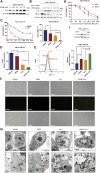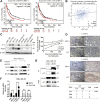Polyphyllin Ⅲ-Induced Ferroptosis in MDA-MB-231 Triple-Negative Breast Cancer Cells can Be Protected Against by KLF4-Mediated Upregulation of xCT
- PMID: 34040532
- PMCID: PMC8141818
- DOI: 10.3389/fphar.2021.670224
Polyphyllin Ⅲ-Induced Ferroptosis in MDA-MB-231 Triple-Negative Breast Cancer Cells can Be Protected Against by KLF4-Mediated Upregulation of xCT
Abstract
Ferroptosis, which is characterized by the accumulation of intracellular iron and subsequent lipid peroxidation, is a newly discovered form of regulated cell death and plays an important role in tumor suppression. Herein, we showed that Polyphyllin III, which is a major saponin extracted from Paris polyphylla rhizomes, exerted its proliferation-inhibitory effect on MDA-MB-231 triple-negative breast cancer cells mainly through ACSL4-mediated lipid peroxidation elevation and ferroptosis induction. ACSL4 deletion partly attenuated Polyphyllin III-induced ferroptosis. Polyphyllin III treatment also induced KLF4-mediated protective upregulation of xCT, which is the negative regulator of ferroptosis. Interestingly, combination with the xCT inhibitor sulfasalazine (SAS) or downregulation of KLF4 sensitized MDA-MB-231 cells to Polyphyllin III. Furthermore, in vivo xenograft models, SAS significantly sensitized MDA-MB-231 breast cancer cells to Polyphyllin III, likely by enhancing intracellular lipid peroxidation and ferroptosis. The results of this study collectively demonstrated that Polyphyllin III exerts its anticancer effect by inducing ferroptosis via ACSL4 in MDA-MB-231 breast cancer cells. More importantly, we observed for the first time that KLF4-mediated xCT upregulation serves as negative feedback during ferroptosis progression, which might contribute to drug resistance in cancer treatment.
Keywords: ACSL4; KLF4; Polyphyllin III; breast cancer; ferroptosis; xCT.
Copyright © 2021 Zhou, Yang, Chen, Li, Chen, Zhang, Wang and Zhou.
Conflict of interest statement
The authors declare that the research was conducted in the absence of any commercial or financial relationships that could be construed as a potential conflict of interest.
Figures






Similar articles
-
Polyphyllin I induces ferroptosis in castration-resistant prostate cancer cells through the ERK/DNMT1/ACSL4 axis.Prostate. 2024 Jan;84(1):64-73. doi: 10.1002/pros.24626. Epub 2023 Sep 26. Prostate. 2024. PMID: 37750290
-
Holo-lactoferrin: the link between ferroptosis and radiotherapy in triple-negative breast cancer.Theranostics. 2021 Jan 1;11(7):3167-3182. doi: 10.7150/thno.52028. eCollection 2021. Theranostics. 2021. PMID: 33537080 Free PMC article.
-
Vulnerability of Triple-Negative Breast Cancer to Saponin Formosanin C-Induced Ferroptosis.Antioxidants (Basel). 2022 Jan 31;11(2):298. doi: 10.3390/antiox11020298. Antioxidants (Basel). 2022. PMID: 35204181 Free PMC article.
-
ACSL4 as a Potential Target and Biomarker for Anticancer: From Molecular Mechanisms to Clinical Therapeutics.Front Pharmacol. 2022 Jul 13;13:949863. doi: 10.3389/fphar.2022.949863. eCollection 2022. Front Pharmacol. 2022. PMID: 35910359 Free PMC article. Review.
-
Ferroptosis, a novel pharmacological mechanism of anti-cancer drugs.Cancer Lett. 2020 Jul 28;483:127-136. doi: 10.1016/j.canlet.2020.02.015. Epub 2020 Feb 14. Cancer Lett. 2020. PMID: 32067993 Review.
Cited by
-
Phytochemicals Targeting Ferroptosis: Therapeutic Opportunities and Prospects for Treating Breast Cancer.Pharmaceuticals (Basel). 2022 Nov 5;15(11):1360. doi: 10.3390/ph15111360. Pharmaceuticals (Basel). 2022. PMID: 36355532 Free PMC article. Review.
-
Upregulation of the ferroptosis-related STEAP3 gene is a specific predictor of poor triple-negative breast cancer patient outcomes.Front Oncol. 2023 Mar 31;13:1032364. doi: 10.3389/fonc.2023.1032364. eCollection 2023. Front Oncol. 2023. PMID: 37064114 Free PMC article.
-
Iron-Dependent Cell Death: Exploring Ferroptosis as a Unique Target in Triple-Negative Breast Cancer Management.Cancer Manag Res. 2025 Mar 19;17:625-637. doi: 10.2147/CMAR.S503932. eCollection 2025. Cancer Manag Res. 2025. PMID: 40124838 Free PMC article. Review.
-
Novel Chemicals Derived from Tadalafil Exhibit PRMT5 Inhibition and Promising Activities against Breast Cancer.Int J Mol Sci. 2022 Apr 27;23(9):4806. doi: 10.3390/ijms23094806. Int J Mol Sci. 2022. PMID: 35563196 Free PMC article.
-
Research progress on the use of traditional Chinese medicine to treat diseases by regulating ferroptosis.Genes Dis. 2024 Nov 6;12(3):101451. doi: 10.1016/j.gendis.2024.101451. eCollection 2025 May. Genes Dis. 2024. PMID: 40070365 Free PMC article. Review.
References
LinkOut - more resources
Full Text Sources
Other Literature Sources
Miscellaneous

